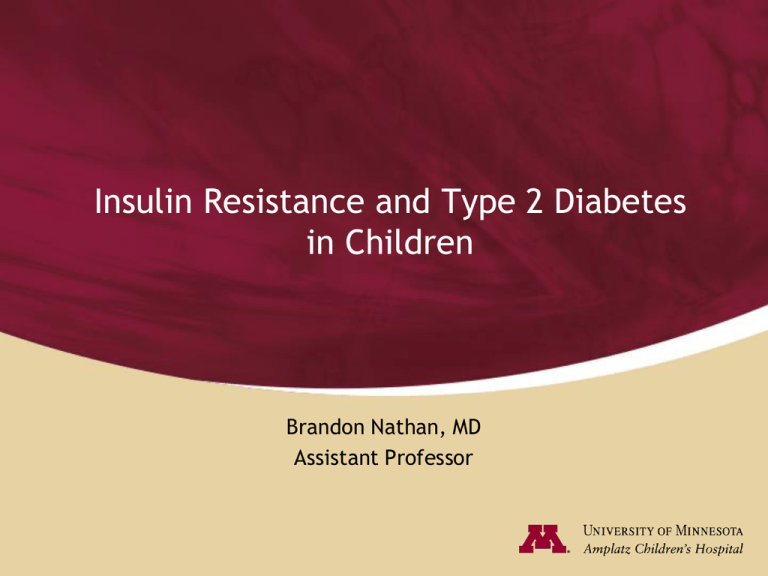
Insulin Resistance and Type 2 Diabetes
in Children
Brandon Nathan, MD
Assistant Professor
Disclosures
• I have no relevant financial relationships with the
manufacturers of any commercial products and/or provider
of commercial services discussed in this CME activity.
• I do intend to discuss an unapproved/investigative use of a
commercial product/device in my presentation.
– Thiazolidenedione and GLP-1 agonist classes of
pharmaceuticals in pediatric type 2 diabetes
Objectives
1.
Recall the relative differences in prevalence rates for type 1
vs. type 2 diabetes among children of different ethnic
backgrounds in the United States
2.
Discuss the risk factors that lead to the development of
type 2 diabetes in children
3.
List the appropriate diagnostic tests to screen an at risk
child for type 2 diabetes and the associated metabolic co
morbidities of insulin resistance/obesity.
Diabetes Etiology: Insulin Supply, Secretion, Demand
Normal
Slide courtesy of Toni Moran, MD
Type 1
Pre-type 2
Type 2
Acanthosis Nigricans:
A Sign of Insulin Resistance
Criteria for the Diagnosis of Diabetes
Test
Criteria (x2)
Fasting plasma glucose
≥ 126 mg/dl
or
Casual glucose
Hemoglobin A1c
Prediabetes: HbA1c 5.7-6.4%
≥ 200 mg/dl with
symptoms
or
≥ 6.5%
IFG: impaired fasting glucose (Fasting glucose 100-125)
IGT: impaired glucose tolerance (2 hr glucose reading
of 140-199 on OGTT)
The Trend in Diabetes is Alarming
• 25.8 million people in the US have diabetes (8.3% of population)
– Additional 79 million have prediabetes
• Overall risk of death twice that of people without diabetes of similar age
• Leading cause of blindness, end stage renal disease, non-traumatic leg
amputation
• 2-4 fold increased risk for cardiovascular disease
• Estimated costs in 2007: $174 billion
• 1 in 3 children born in the US in 2000 will develop diabetes (CDC)
– 50% of African American and Latino children may develop T2DM
Rates of New Cases of Diabetes in US from
2002-2005
Mayer-Davis EJ, et.al. Diabetes Care, 2009
Is Pediatric T2DM a global epidemic?
• Cohort of 535 obese Italian children
IFG (7.6%), IGT (3.2%), T2DM (0.18%)
Cambuli, VM, et.al. Diab Metab Res Rev, 2009
• Prevalence of T2DM among 0-20 year old German children
estimated at 2.3 cases per 100,000.
Neu A, et.al. Pediatric Diabetes, 2009
• Highest risk populations (obese, Latino, positive fam hx) from Los
Angeles from 2000-2007 showed prevalence of 1.3% on OGTT
Goran MI, et.al. J Pediatr, 2008
• Taiwanese children aged 6-18 taking part in screening program
found diabetes prevalence of 9 (♂) and 15.3 (♀) per 100,000
children. After 3 years, 54% of cases identified as type 2.
Wei JN, et.al. JAMA, 2003
NHANES suggests an increase in
prediabetes and diabetes over past 10 years
May AL, et.al. Pediatrics, 2012
How did we get here?
Visceral
Adiposity
Caglecartoons.com
U.S. childhood obesity rates have tripled
over the past 40 years
Obesity: BMI > 95%
Source: CDC (NHANES data)
Obesity rates are highest among
adolescents of ethnic backgrounds
Prevalence of obesity among
boys aged 12-19 years
Source: CDC (NHANES data)
Prevalence of obesity among
girls aged 12-19 years
Popular Teen-Age/Pediatric Grand
Rounds Lunch Items…
• Chipotle
– Chicken Burrito – rice, black beans, cheese, salsa, grilled chicken
– 1154 calories
• Dominos: Slice of Pizza
– Cheese/Veggie: 290 calories, 9 grams fat
– Sausage/Pepperoni: 330 calories, 12 grams fat
• Popular Beverages (Pop, Monster Energy, etc.)
– 16 oz: 200 calories
• Starbucks
– Venti (20 oz) Caramel Macchiato
– 300 Calories
Risks of obesity increases with
sedentary activity
Gortmaker S., et.al. Arch Pediatr Adol Med, 1996; 150: 356-62
Diet & Activity
Genetic Influences
Energy Excess
Carbohydrates
Fats
b-cell
Oxidative Stress
Carbohydrates
Adipocyte
Hepatocyte
Hypertrophy & Hyperplasia
Lipogenesis
Impaired Insulin
Secretion
Steatohepatitis
Oxidative Stress/ROS
Adipokines
Inflammatory
Mediators
Insulin Resistance
Free Fatty
Acids
•Peripheral Insulin Resistance
•Lipid accumulation in peripheral tissues
•Endothelial Dysfunction
Frohnert B, et.al. Rev Endocr Metab Disord, 2008
Intrauterine environment plays important role
in contributing future risk for T2DM
Wei JN, et.al. Diabetes Care, 2003
Primary Factors Contributing to
Development of T2DM in Children
T2DM
OBESITY
FAMILY
HISTORY
OTHER
GENES
• visceral
ACCELERATED
BETA CELL
FAILURE
PRENATAL
ENVT.
IFG/IGT
ETHNIC
BACKGROUND
FEMALE
GENDER
INSULIN
RESISTANCE
SEDENTARY
LIFESTYLE
PUBERTY
Beta-cell secretory abnormalities accompany
progression to T2DM
Bacha F, et.al. Diabetes Care, 2009
Acute, Chronic and Future Complication
Risks
Acute, Life-Threatening Complications of
T2DM in Children
• Diabetic ketoacidosis (DKA)
– May occur in up to 40% of patients
• Non-ketotic hyperosmolar coma
– 1966-2001: 35 cases reported; 2001-2010: 65 cases
– More typical in African-American boys before T2D dx
– Characterized by shock, non-acidosis, stupor/coma
– Fatality rates ~ 40% (BMI-SDS > 2.9)
Rosenbloom A, J Pediatr, 2009
– CHOP: 4.2% of patients over 5.7 year period
Fourtner SH, et.al. Pediatr Diab, 2005
T2DM in childhood predisposes for
earlier onset of nephropathic disease
ESRD IN PIMA INDIANS
Pavkov ME, et.al. JAMA, 2006
Co-morbid metabolic conditions are present at
high rate in children with T2DM
TODAY Cohort (n = 704)
Co-morbidity
Present at Baseline
Low HDL (♀<50, ♂ <40)
80%
High TG (> 200)
10%
Hypertension
14%
ALT 1.5-2.5 > ULN [>2.5 excluded]
3%
Microalbuminuria
13%
Copeland KC, et.al. J Clin Endocrinol Metab, 2011
Adolescents with T2DM are at greater risk
for rapid deterioration in glycemic control
Katz LL, et.al. J Pediatr, 2010
Atherosclerosis begins in Childhood
Berenson GS, et.al. N Engl J Med, 1998
Children with T2DM are at increased risk for
premature cardiovascular disease
• Pediatric Criteria for Metabolic Syndrome (three of five)
1. Fasting glucose ≥ 110 mg/dl
2. Waist circumference ≥ 90th %
3. Triglycerides ≥ 110 mg/dl
4. HDL-C ≤ 40 mg/dl
5. Blood pressure ≥ 90%
• Other Evidence for Premature Cardiovascular Disease
• Increased vascular stiffness
• Higher aortic pulse wave pressure
• Inflammatory cytokines
Screening and Management of
Pediatric Type 2 Diabetes
Who Should be Screened for T2DM? ADA 2013
1.
Overweight Children ≥ 10 years or at puberty:
• BMI >85th percentile for age and sex
• weight for height >85th percentile
• weight >120% of ideal for height
2.
Plus any two other risk factors
• Signs of insulin resistance: acanthosis nigricans, hypertension,
dyslipidemia, PCOS, hx for SGA
• Race: American Indian, African American, Latino, Asian American, Pacific
Islander
• Family history: T2D in 1st or 2nd degree relative
• Maternal history: Diabetes or gestational diabetes
Screen every three years: Fasting glucose, HbA1c, OGTT, random glucose + Sx
Diabetes Care 2011; 34:S11-S61
Others: Fasting lipid (Dyslipidemia), ALT (NAFLD), total and free
testosterone (PCOS), blood pressure
OGTT may
help identify
youth at
greatest risk
Monophasic
Biphasic
Kim JY, et. al. Diabetes Care, 2012
Metformin is only approved oral
agent for pediatric T2DM
• Reduces hepatic glucose output (inhibits gluconeogenesis)
• Facilitates glucose transport in insulin-sensitive tissues
• May normalize ovulatory disturbances in girls with PCOS
• Safely used in children
– Metabolic effects usually apparent within 2 weeks
– May improve LDL, TG, ALT and augment weight loss
– GI side effects – improved if taken with food and lessen over
time
– Rare lactic acidosis or hepatic inflammation
Cumulative Incidence of Diabetes in the
Diabetes Prevention Program
Risk reduction
31% by metformin
58% by lifestyle
Insulin therapy in Pediatric T2DM
•
Necessary at time of diagnosis if marked hyperglycemia present
– Classification of diabetes may not be clear
•
Adjunct to Metformin and lifestyle interventions
•
Accumulating evidence that early insulin therapy for T2DM in adults is
beneficial
•
Many preparations and combinations
– Basal Insulin such as Glargine (Lantus) or Detemir (Levemir)
– Bolus Insulin such as Aspart (Novolog) or lispro (Humalog) for
hyperglycemia correction and meal coverage
– Premixed Insulin (70/30 or 75/25)
Complementary 2nd line therapies are not
approved for Pediatric T2DM Management
1. AGENTS
THAT INCREASE INSULIN SENSITIVITY
Thiazolidinediones: PPARγ activators
rosiglitazone, pioglitazone
α-Glucosidase inhibitors: Inhibit carbohydrate absorption
acarbose, miglitol
2. AGENTS THAT INCREASE INSULIN SECRETION
Sulfonylureas: Stimulate SUR receptor
glyburide, glipizide, gliclazide, glimepiride
Meglitinides
repaglinide, nateglinide
3. AGENTS THAT MIMIC INCRETIN PEPTIDES
GLP-1 agonists
Exenitide, liraglutide
DPP-4 inhibitors
Sitagliptin
•
TODAYs primary objective is to compare the efficacy of three
treatment arms on time to treatment failure based on glycemic control
in newly diagnosed children with T2DM.
The three treatment groups are:
1.
Metformin (500-1000 mg bid)
2.
Metformin (500-1000 mg bid) AND rosiglitazone (4 mg bid)
3.
Metformin plus an intensive lifestyle intervention called the TODAY
Lifestyle Program (TLP).
•
The TLP program is designed to promote healthy, moderate weight loss
through changes in diet and increases in physical activity.
Intervention phase was completed in February, 2011
Primary TODAY Results
Summary
1.
The overall prevalence of T2DM in U.S. youth is ~ 1 in 1000 but is
increasing, especially in non-Caucasians, surpassing rates of type 1.
2.
Rates of diabetes and complications from diabetes in young adults
will reach epidemic proportions in near future.
3.
While many factors are involved, obesity (visceral) and insulin
resistance are central to development of pediatric T2DM.
4.
Additional important risk factors include ethnic background, family
history, birth history.
5.
Screening should include tests for diabetes and for other comorbidities:
− FPG, A1c, lipids, fatty liver disease, BP monitoring, PCOS
6.
The most important treatment is lifestyle change.
− May also include metformin, insulin and management of comorbidities (hypertension, dyslipidemia, etc).
7.
Prevention (policy and societal change, medical interventions,
identification of new pathways) is paramount to our efforts in
combating diabetes now and in the future.
Known and
undiagnosed cases of
pediatric T2D
Undiagnosed cases of
pediatric pre-T2D
(IGT/metabolic syndrome)
“Pre-pre” T2D: insulin
resistance with risk
factors











